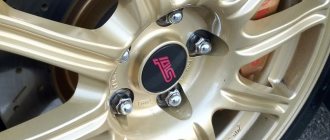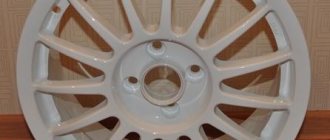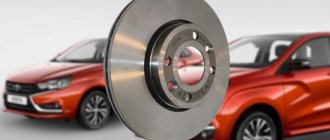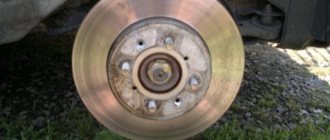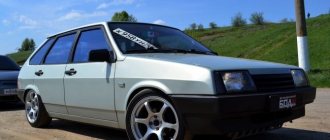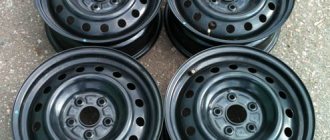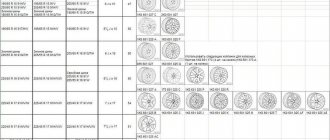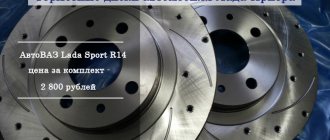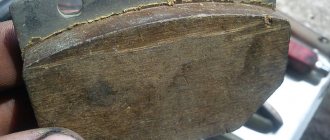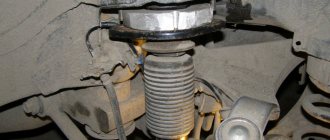Have you decided to update the wheels on your car, but can’t figure out which parameters affect what? We give the answers in this article.
- What parameters are important when selecting car wheels?
- Types of rims
- Landing diameter
- Bolt pattern
- Disc width
- Disc offset
- Hub Bore Diameter
- Availability of humps
Buying new rims is a rare event even for experienced car owners. There are several reasons to update your car's wheelbase:
- current disks have critical damage;
- this is a way to change the appearance of a car;
- New wheels are bought for a second set of tires - this way you can quickly and independently “change your shoes”, without a trip to the tire shop.
Without rims and tires installed, the car will not be able to move.
What parameters are important when selecting car wheels?
Wheel rims vary in design, materials and sizes. The type of disc determines the design and materials. Acceptable wheel sizes are indicated in the vehicle's operating manuals - for each model there may be several acceptable values for some parameters. To make the right choice, take into account:
- disk type;
- landing diameter;
- type of bolt pattern;
- disc width and offset;
- diameter of the central hole;
- presence of humps.
How wheel weight affects acceleration
One of the main parameters that directly affects the speed and dynamics of any car is the weight of the wheel rims. Every experienced car owner knows well that by reducing the weight of the discs, an amazing effect can be achieved: increasing the smoothness of the ride, increasing the maximum speed and making the car's handling easier and safer. But in order to make the effect of improving dynamics more attractive, you need to understand how weight affects each of the above parameters.
Types of rims
Wheel rims are divided into types according to material and production method. There are stamped, cast or forged wheels. The main difference between these types is the type of material used and the production method.
Stamped discs
The most common are stamped discs, made of rolled steel by hot stamping and subsequent welding of two parts - the rim and the front part of the disc. Most of these discs have a simple design and are similar to each other. They are equipped with basic versions of budget cars.
The advantages of stamped discs include low cost, softer running and ease of repair even with severe damage. In the event of an impact, they bend, and such deformation can be corrected.
Stamped wheel rims have several disadvantages - they are heavy, susceptible to corrosion and look unpresentable. They are used in combination with replaceable plastic caps.
Alloy wheels
Most cast car wheels are made from aluminum-based alloys. They are cast in prepared molds. This option is noticeably lighter compared to stamped ones. Alloy wheels improve the speed characteristics of the car due to better aerodynamics and weight, and the appearance of the one-piece element improves the visual perception of your car.
There are also disadvantages: alloy wheels do not absorb impacts from bumps on the road, and with a strong impact they can crack or split, after which they cannot be repaired. Small cracks are removed by welding and polishing, followed by balancing.
The cost of one set of “castings” is usually 2-4 times higher than the cost of steel wheels.
Forged wheels
Forged wheels are rarely found on sale. This is the most expensive option. They are made by hot die forging from aluminum alloys containing magnesium and titanium. The structure of such a metal wheel is the strongest, lightweight and flexible.
When subjected to a strong impact, it behaves like a stamped steel wheel - it does not crack, but bends, which leaves a chance for the disk to be restored.
What to choose?
If you live in a city and travel exclusively on good roads, but do not want to spend extra money, alloy wheels are the best option. Moreover, the car market today offers many high-quality models at an affordable price, the best of which are products from European, Russian and South Korean production, and the worst, respectively, from China and Turkey.
Those who love speed and are unable to drive otherwise should take a closer look at forged wheels, which have greater strength and less weight. In addition, these products are adored by tuning connoisseurs and people with high incomes.
As for stamped steel wheels, they are often chosen for driving on roads with poor surfaces, are used as a replacement for cast models in the winter, and are also used to equip workhorse cars. These discs are inexpensive and allow you to make repairs without outside help, even in the field.
Landing diameter
The bore diameter is the size of the wheel circumference in inches. Depending on the tire size, it can vary by one to three inches. Information about the permissible disc diameter is usually indicated by the manufacturer, and it should be selected according to the make and model of the car. Slight confusion is caused by the designation of the parameter - using the letter “R”, for example R15 or R17 - many people mistake this designation for the radius. This is the diameter!
Larger wheels look cooler, but the larger the wheel size, the greater the load on the suspension parts, reducing the tire profile and reducing its shock-absorbing properties. And smaller wheels may not fit on the brake caliper.
Marking
Recommended wheel rim parameters may vary slightly for the same vehicle, regardless of whether you choose to install a steel, cast or forged rim on your vehicle. But there is a standard disk marking , which looks, for example, like this:
6.5J×15 H2 5/112 ET39 d57.1
Next, we will tell you in order about all the parameters indicated on the disk label:
Bolt pattern
If the bolt pattern is incorrect, it will not be possible to tighten the wheel. Wheel bolt pattern is determined by two parameters:
- number of mounting holes;
- diameter of their location (PCD).
The diameter of the circle on which the mounting holes are located, as well as their number, are specified by the car manufacturer and this parameter should be strictly adhered to. Installing a disk with a PCD deviation of even a couple of millimeters will lead to the fact that such a wheel will “beat” strongly while driving. In addition, loose bolts will unscrew on their own.
For installation, special nuts and bolts are used for fastening the wheels. They can be purchased at tire centers and auto parts stores.
Which car wheels are lighter: forged or cast?
Forged ones are much lighter than cast ones. This is observed due to the fact that during the forging process, “extra” parts are removed from the disks, after which decorative figures of various shapes are cut out on them. Thanks to this form of execution, the wheels have thin walls.
The formula for producing forged wheels is as follows:
- The blank is made by stamping it on two presses with different forces of 10 and 20 tons.
- Next, the forging is carried out through a metal-cutting machine.
- Using a machine, holes and spokes are made on the surface of the wheels.
Disc width and flange shape
Wheel width is also indicated in inches and indicates the distance between the inner surfaces of the rim flanges. The shape of the flange, the place where the disk connects to the tire, varies and is marked with letters - the most popular is J. All-wheel drive vehicles are sometimes equipped with wheels with a JJ rim shape.
There is a permissible error when choosing the required disk width. To determine the width of the wheel rim, you need to add another 26 mm to the rim width value on the marking, that is, the thickness of the outer and inner side flanges. The permissible error is approximately 4mm.
Thus, an increase in wheel width, coupled with wide tires, can have a positive effect on braking dynamics and lateral load margin. However, this increases the overall weight of the car and increases fuel consumption.
Smooth ride
Calculations show that reducing the weight of each wheel by at least one kilogram is equivalent to reducing the weight in the cabin by 40 kilograms. In practice, we can give the following example: if you reduce the weight of each wheel by four kilograms (this is not difficult to do, considering how much one forged rim weighs), then the smoothness of the ride will be the same as if you had four passengers in the cabin. Overclocking characteristics will remain at the same level.
The answer to the question “Which wheels are lighter, forged or cast?” everyone knows. For example, one original 20-inch cast rim for Range Rover weighs about 25 kilograms. A forged analogue with a maximum static load for the same car is about 13 kilograms. Each wheel is approximately 12 kg lighter. As a result, forged wheels make it possible to reduce unsprung weight by almost half a ton, and improved ride smoothness is achieved without loss of dynamics and acceleration characteristics.
Disc offset
Disc offset is designated ET. This is the distance between the plane where the disc comes into contact with the hub and the middle of the disc width. The offset can be positive, negative or zero. The lower the offset, the more the wheel protrudes outward.
Do not install wheels with an abnormal offset on your car; the optimal indicator is indicated by the manufacturer of the car model. This changes the track and leads to accelerated wear of the chassis elements. The car will become less controllable, and the disc may touch brake and suspension parts.
The offset is changed only on professional sports cars, making sure to adjust other parameters as well.
When you should not use cast rims for cars
In general, they can be used in all situations. The only thing is, if the rim size is not suitable for a particular car, then you should not install it. Among the advantages of using them are minimal weight, as well as the ability to abandon the constant use of caps, which are endlessly lost. In addition, light alloy cast rims have an attractive aesthetic appearance and can serve as car decoration.
At the purchasing stage, you need to look at what markings are applied to certain rims and if questions arise, then in such a situation it makes sense to contact the seller to provide them with advice. If you often drive outside of paved roads, then you should not give preference to alloy wheels, since this choice will not be justified.
If you have chosen them, then in this case you should drive through railway intersections and other obstacles as carefully as possible, even if you are sure that the manufacturer used high-quality raw materials.
Hub Bore Diameter
The hub seat ring and the central hole of the disc must be the same diameter. For car rims, the diameter of the central hole is measured in millimeters.
If it is smaller than the seat ring on the hub, the wheel cannot be installed. A disk with a central hole larger than the standard one (indicated by the manufacturer in the documentation) can be screwed on. For tight installation, in this case, additional centering rings are used. This option only works when installing alloy wheels - there must be strict compliance with stamped ones.
MAX LOAD
There is one more additional parameter that has nothing to do with the size of the disk, but it is important for the correct selection of the disk. This parameter is called MAX LOAD - maximum load on the disk. For passenger cars, rims are usually made with a safety margin, but if rims for a passenger car are placed on a jeep or minibus, they may not withstand the load and become deformed if they fall into even a minor hole. Therefore, when choosing wheels for a jeep or other heavy vehicle, be sure to pay attention to the recommended maximum load on the disk. MAX LOAD is measured in pounds or kilograms. To convert pounds to kilograms, you need to divide them by a factor of 2.2
.
For example, if the specified load is 2000
lbs (2000LB) then:
MAX LOAD = 2000LB = 2000 / 2.2 = 908 kg
Availability of humps
The wheel is marked with the letter “H”. It is responsible for the features of the ring protrusions - humps. They hold the tubeless tire on the rims. In most cases, two humpas (H2) are placed on the wheel. If a single hump is used, then its shape is additionally indicated:
- FH – flat;
- AH – asymmetrical;
- CH – combined.
Wheels without humps are only used on some vintage cars that use tubed tires.
It is easy for a novice car owner to get confused in the extensive parameters and technical characteristics of spare parts. Most of them have tables for different brands and models of cars, from which you can find out, for example, the diameter of the hub and the type of bolt pattern. It is important to decide on the preferred type of disk: whether you choose heavy, but inexpensive and reliable stamped disks, or give preference to the stylish, but expensive and fragile “casting”. Both options are widely represented in our catalog - choose new wheels and go!
Tuning stamping
One of the options for improving the appearance of stamping is to paint the stamped discs yourself.
Painting stampings requires the presence of:
- spray gun;
- compressor;
- paints;
- solvent;
- sandpaper.
Painting stampings always begins with diagnostics. Discs with a diameter of 13, 14, 16 and others should not be damaged or dirty. They are processed with sandpaper, thoroughly washed, dried and degreased.
First, a primer is applied in 2-3 layers, which, after it dries, must be sanded with sandpaper. The next step is painting the stampings. Using a spray gun, apply 2-3 layers of paint; acrylic is best suited for this. After this, the stamping can be varnished.
Chrome stampings are also in great demand among car owners. This protective and decorative coating is quite expensive.
Useful! Chrome plated discs have good protective properties if the layer thickness is from 20 to 50 microns. A thinner layer will not protect against corrosion.
Chrome stampings can be made using a wear-resistant or decorative type of chrome plating.
In the first case, hard chrome is applied to the steel. The coating thickness is 10-300 microns, which makes chrome wheels harder and more wear-resistant.
In the second case, a layer of nickel is applied to the steel, then a layer of copper, the next layer is semi-shiny nickel, then shiny nickel and, finally, a layer of transparent chrome, which protects the nickel from tarnishing. Particular attention is paid to polishing - this is a long and labor-intensive process. Chrome stampings give the car uniqueness and presentability.
